The Intel Core i7-12700K and Core i5-12600K Review: High Performance For the Mid-Range
by Gavin Bonshor on March 29, 2022 8:00 AM ESTGaming Performance: iGPU
All of our game testing results, including other resolutions, can be found in our benchmark database: www.anandtech.com/bench. All gaming tests here were run using integrated graphics, with a variation of 720p resolutions and at minimum settings.
We are using DDR5 memory for Alder Lake at the following settings:
- DDR5-4800(B) CL40
All of AMD's Ryzen APUs were tested with DDR4 memory at the relevant JEDEC specifications of each chip.
Final Fantasy 14
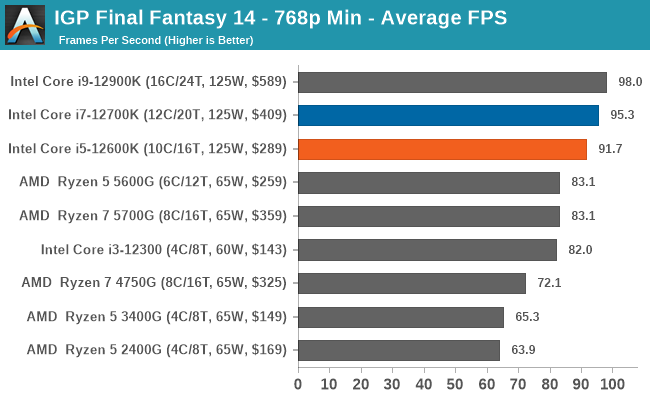
World of Tanks

Borderlands 3
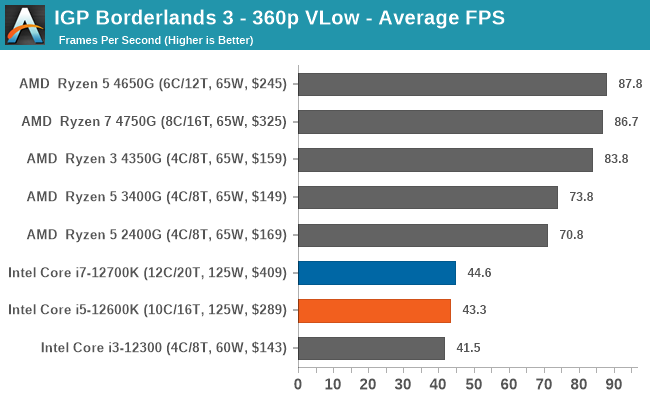
Far Cry 5

Gears Tactics
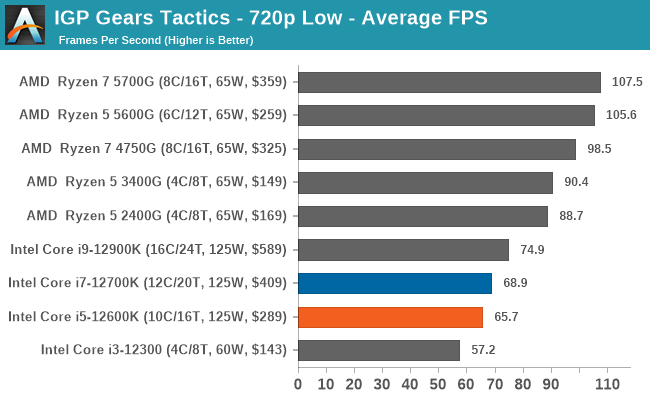
Grand Theft Auto V
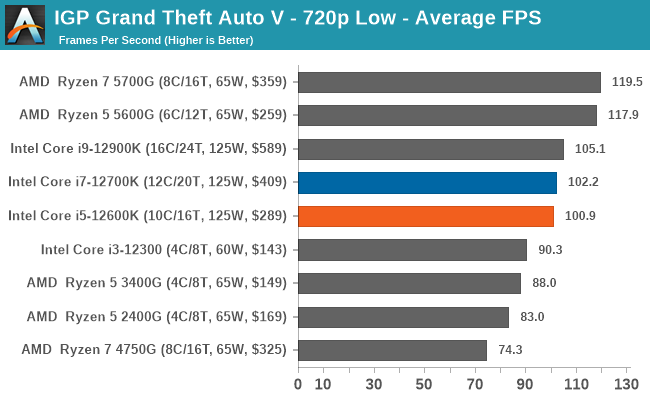
Strange Brigade (DirectX 12)
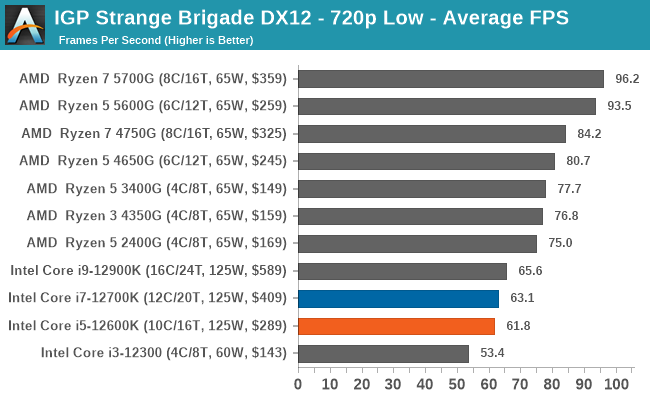
Performance on Intel's UHD 770 integrated graphics when compared to AMD's Ryzen APUs came solely down to the intensity of the game title. In scenarios where titles favor CPU grunt, the 12th Gen Core series processors did well, but when it came to graphical performance, UHD 770 clearly trails AMD's integrated Radeon graphics.
The consensus here is that in all scenarios, AMD's Ryzen APUs are superior to Intel for low-budget gaming systems where discrete graphics aren't used. Intel really only makes the bare minimum investment in die space for their iGPU here, and it shows: UHD 770 is good enough for the bare minimum in gaming, and that's about it.










196 Comments
View All Comments
Otritus - Wednesday, March 30, 2022 - link
Chiplets should not give much of a pricing advantage. Going from monolithic dies to chiplets adds manufacturing, validation, and design costs. You save money from the chiplets having better yields and being able to reuse chiplets (like AMD did with their IO die). Intel’s consumer processors aren’t that big and yields are good, so it’s probably a wash overall in pricing (excluding the money Intel saves from in-house manufacturing). Chiplets would be a competitive advantage for big processors (EPYC vs Xeon or Navi 31 vs AD102) because of yields.vlad42 - Friday, April 1, 2022 - link
Nonsense, chiplets absolutely provide a price advantage once you are using more than one CPU chiplet. There's a reason why AMD has done so well in the HEDT, workstation, and server markets. The chiplets allow them to provide more cores for less money than Intel (the yields on those high core count monolithic chips are abysmal by comparison).Qasar - Friday, April 1, 2022 - link
ive read somewhere thats part of the reason why intel cant offer more cores then they do, and why they also went with the P/E core setup. they just can't make the cpus that big with the big cores.mode_13h - Saturday, April 2, 2022 - link
Die size gets expensive as you scale it up, because not only do you get fewer chips/wafer, but yield becomes a major factor. This is even more true on a young process, such as "Intel 7", and why smaller chips tend to be the first to utilize them.In one way or another, cost is *always* a factor, whenever companies are deciding on the parameters of a new chip.
Qasar - Saturday, April 2, 2022 - link
i think, the other reason was power consumption, if intel uses this much power with what 10 P cores ( and no e cores ) i dont want to know what 12, or even 16 cores would use.mode_13h - Sunday, April 3, 2022 - link
> if intel uses this much power with what 10 P cores ( and no e cores )> i dont want to know what 12, or even 16 cores would use.
That's not necessarily a direct tradeoff. They could cap the power (i.e. clocks) and still deliver more performance than 8 P-cores.
Of course, the other thing they could do is trade more die area & clock speed for a uArch with higher IPC, like Apple's. But die area costs $.
The sad reality (for the planet) is that the winning strategy seems to be making less-sophisticated cores that simply clock really high. That gets you winning headline numbers on lightly-threaded benchmarks. Then, wedge in some throughput-optimized cores, so you can also do well on heavily-threaded workloads.
Qasar - Sunday, April 3, 2022 - link
just saw a review of the 12900ks, to me, when a reviewer types " the Core i9-12900KS represents Intel throwing value and power consumption out the window in a no-holds-barred attempt to retain the performance crown, particularly in gaming. " screams desperation. looks like one of the ways intel is only able to compete, is by doing this.Mike Bruzzone - Tuesday, April 5, 2022 - link
@Otritus, I agree MCMs trade off packaging cost for monolithic die fabrication cost. Moving to Systems in Package in the near term will eclipse their dice fabrication costs; "manufacturing, validation, and design costs". mbKhanan - Thursday, April 7, 2022 - link
Last time I checked 5950X had still more performance despite being challenged by a 250W auto OC 12900K. I mean, imagine, you can easily activate auto OC on 5950X with activating PBO too. And yep it crushes the 12900K then. Reviews that don’t reflect this are as per usual kinda trashy.mode_13h - Wednesday, March 30, 2022 - link
> They have 90-95% of the performance for less than half, or in some cases, 1/3rd the power.I don't see how you can draw that conclusion, when the article only lists *peak* power. What's needed is joules per test, for the fixed-size tests.